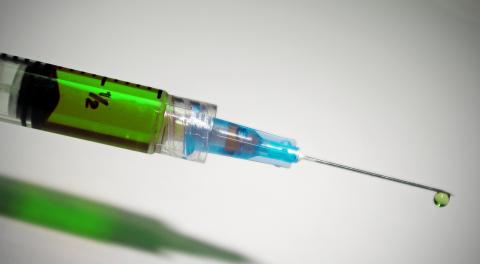
Hundreds of millions of adults around the world can expect to be vaccinated against Covid over the next few months. It will be delivered by hypodermic syringe - but who invented it?
Most people with access to healthcare take vaccinations for granted. The syringe that is now being used to provide protection against Covid may look simple enough - but appearances can be deceptive. It took millennia to create the hypodermic syringe in a form that was to allow mass vaccinations to take place today. An Irish surgeon, Francis Rynd, and French physician, Charles Pravaz, made a huge contribution to the field in the mid-19th Century. But it was a Scottish doctor, Alexander Wood, who is now widely credited with inventing the modern-day hypodermic syringe. Wood may have had little idea of the importance of his invention in the 1850s. But his creation of an all-glass syringe with plunger and fine-bore needle was to become as recognisable a medical device as the stethoscope.
Syringes in some form or another have been around at least since the time of the Greek physician Hippocrates in the 5th Century BC. Early versions were crude. Constructed of animal bladders and pipes or quills, they were largely used for irrigation - the practice of washing out or flushing a wound or body - or enemas. In the 11th Century, an Egyptian ophthalmologist used the first known hypodermic-like tool to remove cataracts. But it wasn't until the mid-17th Century that the earliest confirmed experiments in intravenous injection were undertaken. In experiments with dogs in 1656, Britain's Sir Christopher Wren - better known as an architect - administered drugs using an animal bladder attached to a hollow goose quill. "He injected opium, alcohol and crocus metallodrug (a 17th Century emetic) into different dogs," explains anaesthetist Christine Ball, honorary curator of the Geoffrey Kaye Museum of Anaesthetic History in Melbourne. "As we would expect, the first went to sleep, the second became very drunk and the third became very dead."
By the time Edward Jenner, who created the world's first vaccine, appeared on the scene nearly 150 years later, there was still no sign of a sophisticated method of administering drugs into the human body. In 1796, he successfully vaccinated an eight-year-old boy against smallpox. However, the vaccine was administered through a cut, and so was not technically an injection. By the mid-19th Century, medical minds had begun to focus on a more efficient system of drug delivery. In 1844, Irish surgeon Francis Rynd invented what was arguably the world's first hollow needle. But it was a device which used gravity to make the liquid flow and involved breaching the skin with a tool known as a trocar. Within 10 years, however, the modern version of the hypodermic needle was born.
In 1853, Fife-born physician Alexander Wood added a plunger and developed the first all-glass syringe that allowed doctors to estimate dosage based on the amount of liquid observed through the glass. His first patient was an 80-year-old woman who suffered from a form of neuralgia. Concerned only with relieving localised pain, he injected her with 20 drops of vinous solution of morphia (morphine dissolved in sherry wine) at a point in her shoulder where the pain was most severe. She subsequently went into a deep sleep but later recovered. Wood's invention coincided in the same year, by all accounts completely by chance, with the creation of a similar instrument by French surgeon Charles Pravaz. But while Wood's device was made of glass and featured a plunger, Prava's invention was composed largely of silver and used a screw that had to be turned to push medicine into the body.
Wood's treatment by subcutaneous injection rapidly became popular in Great Britain. His instruments were advertised as "Dr Alexander Wood's narcotic injection syringes". Several years passed before a London surgeon, Charles Hunter, coined the term "hypodermic", based on the Greek words "hypo" (under), and "derma" (skin). The Royal College of Physicians of Edinburgh (RCPE) says there are two reasons Wood - a past president of the organisation - should be given credit over Pravaz.
Daisy Cunynghame, library and heritage manager for the RCPE, explains: "Firstly, Wood trialled his new syringe by using it to inject a patient with medicine (morphine) while Pravaz tested his on a sheep. So the efficacy of Wood's method was more clear. "Secondly, Pravaz died before he published his findings - while Wood published about his discovery." Dr Cunynghame says the modern day hypodermic needle has changed remarkably little from Wood's design. "The main difference has been in the material the syringe is made from - more disposable plastics, less glass and metal, but other than that the design remains largely unchanged. "The sort of precise doses needed for many medicines, including vaccinations, have only been made possible by Wood's invention."